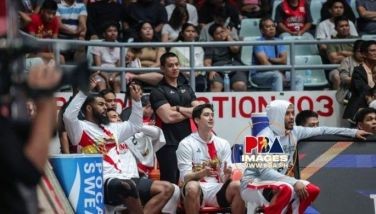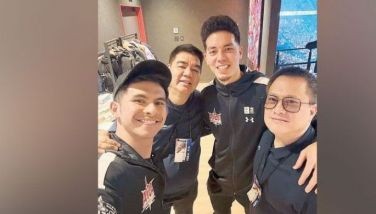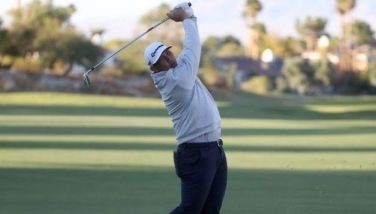The Battleground That Was Iwo Jima
January 21, 2007 | 12:00am
I was told the slopes of Mount Suribachi sometimes run red with rust, like blood, from shells left from the battle for Iwo Jima but what struck me most was the tranquillity of the grassy hillsides.
A blue sky and a soft, warm wind made it hard to connect this tiny island to the place where thousands of Japanese and Americans were shot, blown up or burned to death on beaches, in fields and in tunnels in one of the crucial battles of the Pacific during World War Two.
At one stop on a rare media tour of the island with Japanese military escorts, a rusting Japanese naval artillery piece sat with an empty bird’s nest in the barrel.
Volcanic seams that vent sulphurous smoke made parts of Iwo Jima, whose name means "Sulphur Island," smell like rotten eggs.
From an abandoned bunker that had been reinforced with salvaged metal from an airplane fuselage, I looked out across golden fields to Mount Suribachi.
Lit by a late afternoon sun, the extinct volcano was where six U.S. Marines were photographed on February 23, 1945, raising an American flag–a picture that became a symbol of courage and honor.
A loud crack and then a tearing sound broke the peace as a trio of Japanese air force F-15s sped through the sky. The island now hosts a Japanese military facility with about 350 personnel.
Were it not for those sorties, I could have imagined myself a tourist visiting a cathedral or ancient ruins.
I hadn’t seen Clint Eastwood’s duo of films, "Flags of Our Fathers" and "Letters from Iwo Jima," which have rekindled interest in the battle and prompted the tour of the island.
But I remembered documentaries showing scenes of artillery-scarred landscapes and U.S. Marines attacking tunnels with flamethrowers, burning unseen Japanese soldiers within.
Iwo Jima and its airfields were the prize the United States needed so that fighter planes could escort bombers all the way to Tokyo.
The Japanese knew they had no hope of victory, but to delay the U.S. victory and attack on the mainland, they built miles of tunnels and bunkers across the island from which they could be dislodged only with flamethrowers, hand grenades and small arms.
The strategy prolonged the battle for more than a month, taking the lives of more than 6,800 U.S. Marines and 21,000 Japanese defenders.
It wasn’t until I entered a dirt-floored tunnel that I was able to connect the history with the ground beneath my feet. The tunnel, once a Japanese navy hospital, was wide enough for two people and tall enough to stand in, bigger than most.
The air was uncomfortably close and hot. Then the passage narrowed and the temperature shot up.
It felt as if someone had opened an oven door just inches away, bathing me in heat that made me instinctively want to flee.
This was what hell must be like, I thought, a choking heat and pressed in on all sides by other bodies and inescapable rock walls. Yet Japanese soldiers endured it and fought for weeks until they died or were killed.
Only a handful allowed themselves to be captured.
The last stop on the tour was the top of Mount Suribachi.
There, students from the Japanese defense academy were paying their respects to the dead. They assembled in uniform in front of a Japanese memorial and then poured water from their canteens on its stones as a ritual offering.
At a U.S. Marine memorial, they lined up at attention, bowed, and then closed their eyes for a moment of silence.
No flags are flying there now.
A blue sky and a soft, warm wind made it hard to connect this tiny island to the place where thousands of Japanese and Americans were shot, blown up or burned to death on beaches, in fields and in tunnels in one of the crucial battles of the Pacific during World War Two.
At one stop on a rare media tour of the island with Japanese military escorts, a rusting Japanese naval artillery piece sat with an empty bird’s nest in the barrel.
Volcanic seams that vent sulphurous smoke made parts of Iwo Jima, whose name means "Sulphur Island," smell like rotten eggs.
From an abandoned bunker that had been reinforced with salvaged metal from an airplane fuselage, I looked out across golden fields to Mount Suribachi.
Lit by a late afternoon sun, the extinct volcano was where six U.S. Marines were photographed on February 23, 1945, raising an American flag–a picture that became a symbol of courage and honor.
A loud crack and then a tearing sound broke the peace as a trio of Japanese air force F-15s sped through the sky. The island now hosts a Japanese military facility with about 350 personnel.
Were it not for those sorties, I could have imagined myself a tourist visiting a cathedral or ancient ruins.
I hadn’t seen Clint Eastwood’s duo of films, "Flags of Our Fathers" and "Letters from Iwo Jima," which have rekindled interest in the battle and prompted the tour of the island.
But I remembered documentaries showing scenes of artillery-scarred landscapes and U.S. Marines attacking tunnels with flamethrowers, burning unseen Japanese soldiers within.
Iwo Jima and its airfields were the prize the United States needed so that fighter planes could escort bombers all the way to Tokyo.
The Japanese knew they had no hope of victory, but to delay the U.S. victory and attack on the mainland, they built miles of tunnels and bunkers across the island from which they could be dislodged only with flamethrowers, hand grenades and small arms.
The strategy prolonged the battle for more than a month, taking the lives of more than 6,800 U.S. Marines and 21,000 Japanese defenders.
It wasn’t until I entered a dirt-floored tunnel that I was able to connect the history with the ground beneath my feet. The tunnel, once a Japanese navy hospital, was wide enough for two people and tall enough to stand in, bigger than most.
The air was uncomfortably close and hot. Then the passage narrowed and the temperature shot up.
It felt as if someone had opened an oven door just inches away, bathing me in heat that made me instinctively want to flee.
This was what hell must be like, I thought, a choking heat and pressed in on all sides by other bodies and inescapable rock walls. Yet Japanese soldiers endured it and fought for weeks until they died or were killed.
Only a handful allowed themselves to be captured.
The last stop on the tour was the top of Mount Suribachi.
There, students from the Japanese defense academy were paying their respects to the dead. They assembled in uniform in front of a Japanese memorial and then poured water from their canteens on its stones as a ritual offering.
At a U.S. Marine memorial, they lined up at attention, bowed, and then closed their eyes for a moment of silence.
No flags are flying there now.
BrandSpace Articles
<
>
- Latest
- Trending
Trending
Latest
Trending
Latest
Recommended


















